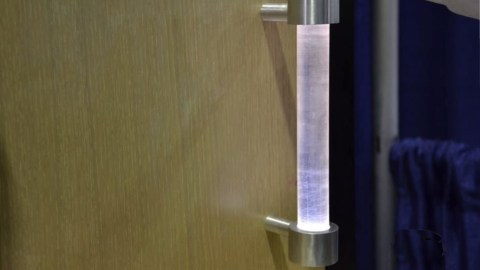Students develop door handles that kill bacteria

- A pair of students in Hong Kong have created a self-cleaning door handle.
- The device uses ultraviolet light to cause a chemical reaction that kills germs.
- In tests, it was able to kill 99.8% of microbes on the door handle.
Think of the most germ covered places in any building. I’ll bet you included door handles on that list. It is a well-studied fact that a filthy door handle can spread disease in short order. Some people won’t even touch the handle of a bathroom door if they can avoid it. However, the days of the infectious door handle may be nearing an end. A pair of graduates from the University of Hong Kong have invented a door handle that uses ultraviolet light to keep itself germ-free.
The looming superbug crisis: Politics, profit, and Big Pharma
The handle is a glass tube with aluminum handles at either end. A thin layer of titanium dioxide covers the glass. When this is bathed in UV light, it sets off a chemical reaction that destroys germs. The UV light itself is powered by a small generator that uses the kinetic energy of the opening and closing of the door to produce electricity.
The principle is largely the same as the one used for ultraviolet water purification systems.
Attempts to keep door handles clean is nothing new. Most people make a point of cleaning door handles during a disease outbreak, and making frequently touched objects, like door handles, out of a germ-resistant material like brass or silver has been a practice for centuries. However, this system is much more effective than anything tried before. Tests showed 99.8% of microbes being killed off by the UV light.
The creators of the handle, Sum Ming Wong and Kin Pong Li, explained that it was primarily inspired by the experience of the SARS epidemic in the early 2000s.
As they told the James Dyson Award team, “In 2003, SARS spread out in Hong Kong. It infected thousands and killed hundreds here. People noticed the importance of public health. We knew that many infection can spread out by contact, for example, SARS, MERS, Foot and Mouth Disease and Candida auris. Then, we decided to design door handle to public to prevent those infection to spread out and enhance public hygiene.”
They also pointed out that the system is less harmful to humans than chemical cleaners and cannot be accidentally wiped off.
The inventors hope to mass-produce the product and bring it to a public space in the near future. The invention is already gathering a fair amount of attention. It was a winning entry in this year’s James Dyson Awards and is now an entry for the international grand prize phase of that competition.





